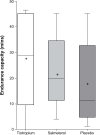Bronchodilation improves endurance but not muscular efficiency in chronic obstructive pulmonary disease
- PMID: 21660300
- PMCID: PMC3107699
- DOI: 10.2147/COPD.S17482
Bronchodilation improves endurance but not muscular efficiency in chronic obstructive pulmonary disease
Abstract
We hypothesized that bronchodilator treatment not only improves hyperinflation and endurance capacity but also muscular efficiency in stable chronic obstructive pulmonary disease (COPD). We aimed to demonstrate that tiotropium and salmeterol improve muscular efficiency compared with placebo. Twenty-five COPD patients were studied, including 20 males of mean (standard deviation) age 62 years (7 years) with baseline forced expiratory volume in 1 second of 41% (10%) predicted, and maximal workload of 101 Watt (36 Watt). Subjects were randomized for 6-week treatment with tiotropium 18 μg once daily, salmeterol 50 μg twice daily, or placebo using a double-blind, crossover design. Muscular efficiency and endurance time were measured during cycling at 50% of maximal work load. Resting energy expenditure was measured using a ventilated hood. Muscular efficiency after tiotropium, salmeterol, and placebo treatment was 14.6%, 14.4%, and 14.4%, respectively (P > 0.05), and resting energy expenditure was 1485 kcal/24 hours, 1709 kcal/24 hours, and 1472 kcal/24 hours (P > 0.05), respectively. Endurance time after tiotropium treatment was significantly higher than that after placebo (27.0 minutes versus 19.3 minutes [P = 0.02]), whereas endurance time after salmeterol treatment was not higher than that after placebo (23.3 minutes [P = 0.22]). In this small study, we were not able to demonstrate that bronchodilator therapy improved muscular efficiency. Apparently, reduced costs of breathing relative to total energy expenditure were too small to be detected.
Keywords: bronchodilation; chronic obstructive pulmonary disease; energy expenditure; muscle energetics; muscular exercise.
Figures
References
-
- Cooper CB. The connection between chronic obstructive pulmonary disease symptoms and hyperinflation and its impact on exercise and function. Am J Med. 2006;119:21–31. - PubMed
-
- O’Donnell DE, Voduc N, Fitzpatrick M, Webb KA. Effect of salmeterol on the ventilatory response to exercise in chronic obstructive pulmonary disease. Eur Respir J. 2004;24:86–94. - PubMed
-
- Maltais F, Hamilton A, Marciniuk D, et al. Improvements in symptom-limited exercise performance over 8 h with once-daily tiotropium in patients with COPD. Chest. 2005;128:1168–1178. - PubMed
-
- Van Noord JA, Smeets JJ, Otte A, et al. The effect of tiotropium, salmeterol and its combination on dynamic hyperinflation in COPD. Proc Am Thorac Soc. 2005;2:A542.
-
- Perrault H. Efficiency of movement in health and chronic disease. Clin Invest Med. 2006;29:117–121. - PubMed
Publication types
MeSH terms
Substances
LinkOut - more resources
Full Text Sources
Medical




